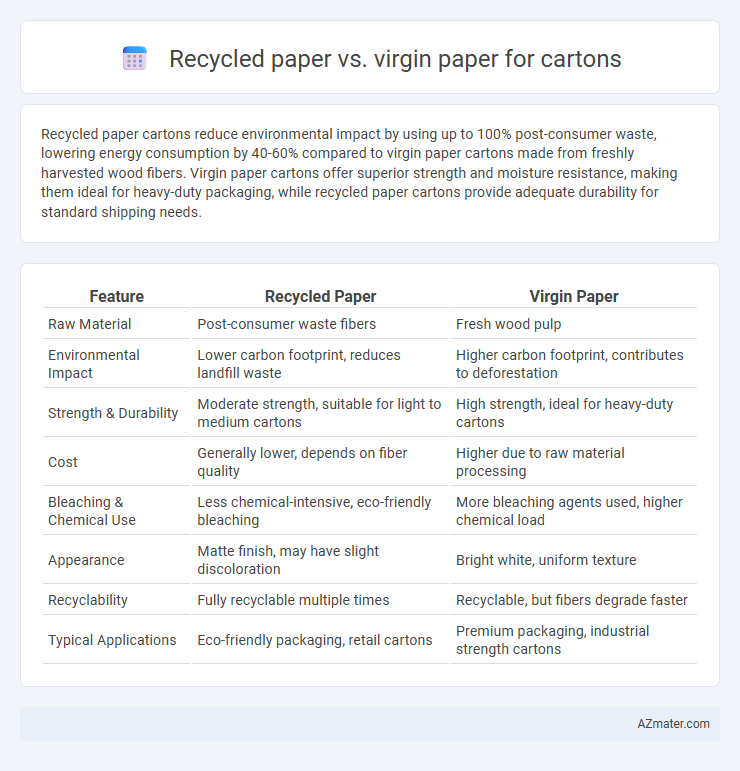Recycled paper cartons reduce environmental impact by using up to 100% post-consumer waste, lowering energy consumption by 40-60% compared to virgin paper cartons made from freshly harvested wood fibers. Virgin paper cartons offer superior strength and moisture resistance, making them ideal for heavy-duty packaging, while recycled paper cartons provide adequate durability for standard shipping needs.
Table of Comparison
| Feature | Recycled Paper | Virgin Paper |
|---|---|---|
| Raw Material | Post-consumer waste fibers | Fresh wood pulp |
| Environmental Impact | Lower carbon footprint, reduces landfill waste | Higher carbon footprint, contributes to deforestation |
| Strength & Durability | Moderate strength, suitable for light to medium cartons | High strength, ideal for heavy-duty cartons |
| Cost | Generally lower, depends on fiber quality | Higher due to raw material processing |
| Bleaching & Chemical Use | Less chemical-intensive, eco-friendly bleaching | More bleaching agents used, higher chemical load |
| Appearance | Matte finish, may have slight discoloration | Bright white, uniform texture |
| Recyclability | Fully recyclable multiple times | Recyclable, but fibers degrade faster |
| Typical Applications | Eco-friendly packaging, retail cartons | Premium packaging, industrial strength cartons |
Introduction to Carton Materials: Recycled vs Virgin Paper
Recycled paper for cartons is made from post-consumer waste, reducing deforestation and lowering environmental impact through decreased energy and water usage compared to virgin paper. Virgin paper, produced directly from fresh wood pulp, offers superior strength and uniformity crucial for heavy-duty packaging applications. Selecting between recycled and virgin paper depends on balancing sustainability goals with performance requirements in carton manufacturing.
Environmental Impact: Recycled Paper vs Virgin Paper
Recycled paper for cartons significantly reduces carbon emissions and conserves natural resources by reusing fibers, lowering deforestation rates compared to virgin paper. Virgin paper production consumes more energy and water, contributing to higher greenhouse gas emissions and greater environmental degradation. Utilizing recycled paper supports waste reduction and promotes a circular economy in the packaging industry.
Manufacturing Processes Compared
Manufacturing recycled paper for cartons involves collecting and processing post-consumer waste, which reduces energy consumption by up to 40% compared to producing virgin paper from timber, requiring fewer trees and less water. Virgin paper production uses fresh wood pulp obtained through mechanical or chemical pulping, creating stronger fibers but with higher environmental impact due to deforestation and increased greenhouse gas emissions. The recycling process also includes de-inking and fiber recovery stages essential for maintaining carton strength and printability, balancing sustainability with quality demands in packaging.
Strength and Durability Differences
Recycled paper cartons often exhibit lower strength and durability compared to virgin paper cartons due to fiber shortening during the recycling process, which reduces tensile strength and resistance to tearing. Virgin paper cartons benefit from longer, intact fibers that provide superior stiffness, load-bearing capacity, and resilience to moisture-related damage. These differences make virgin paper cartons more suitable for heavy-duty packaging applications requiring high durability and structural integrity.
Cost Analysis: Which is More Economical?
Recycled paper for cartons typically costs less due to lower raw material expenses and reduced energy consumption during production compared to virgin paper, which involves logging and pulping fresh timber. The price differential can range from 10% to 30%, depending on market conditions and scale of manufacturing. However, recycled paper may have higher processing costs in some cases, but overall it remains the more economical choice for carton production.
Print Quality and Appearance
Recycled paper for cartons often exhibits a slightly rougher texture and lower brightness, impacting print sharpness and color vibrancy compared to virgin paper. Virgin paper, derived from fresh wood pulp, provides a smoother surface and higher whiteness, enhancing ink adhesion and producing clearer, more vivid prints. Selecting virgin paper ensures superior appearance and consistent quality for high-end carton packaging.
Supply Chain and Availability
Recycled paper for cartons offers significant sustainability benefits but can face supply chain variability due to fluctuating availability of quality post-consumer fiber, leading to inconsistent inventory levels. Virgin paper provides more reliable supply chain stability with consistent raw material sources, ensuring steady availability for high-volume carton production. Manufacturers often balance recycled content with virgin fibers to optimize both ecological impact and supply chain dependability.
Regulatory and Certification Standards
Recycled paper cartons often comply with stringent regulatory standards such as FSC Recycled and EU Ecolabel certifications, ensuring sustainable sourcing and reduced environmental impact. Virgin paper cartons typically hold certifications like FSC Mix or PEFC, which verify responsible forest management but involve higher resource consumption. Both materials must meet food safety regulations including FDA and EFSA guidelines when used for packaging consumables, emphasizing the importance of certification in confirming safety and sustainability.
Sustainability Initiatives in the Carton Industry
Recycled paper cartons significantly reduce deforestation and lower carbon emissions compared to virgin paper, supporting circular economy principles within the packaging sector. Sustainability initiatives in the carton industry emphasize increasing recycled content to minimize environmental impact while maintaining product durability and safety standards. Advances in recycling technology and certification programs like FSC and SFI drive industry-wide commitments to responsible sourcing and waste reduction.
Choosing the Right Paper for Your Carton Needs
Recycled paper offers environmental benefits and cost savings for carton production, featuring lower resource consumption and reduced landfill waste compared to virgin paper. Virgin paper provides superior strength, durability, and print quality, making it ideal for cartons requiring high structural integrity and premium presentation. Choosing the right paper depends on your carton's purpose, desired sustainability level, and budget considerations, balancing recycled content against performance requirements.

Infographic: Recycled paper vs Virgin paper for Carton
 azmater.com
azmater.com